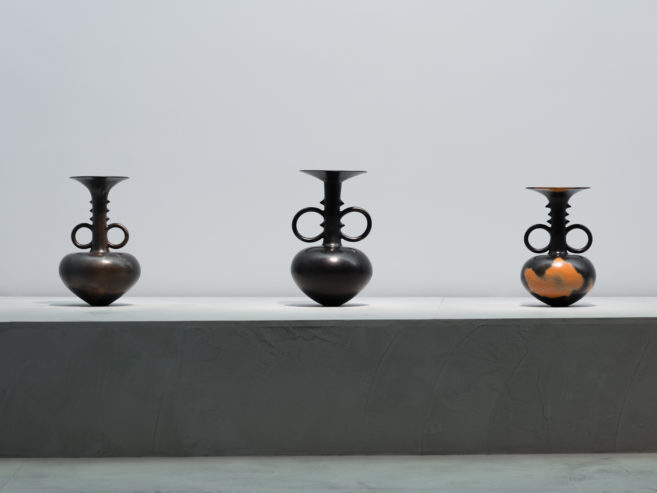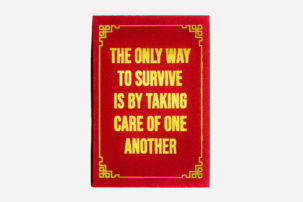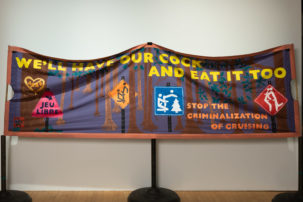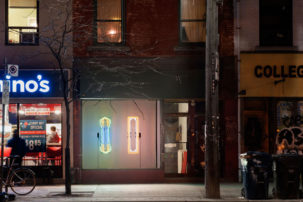Anna Joan Taylor
Intrigued by the history of handmade sex toys, multidisciplinary artist Anna Joan Taylor has been crafting ceramic dildos and butt plugs for the last few years. One such piece is a porcelain tentacle, with small pearly nodules peeking out of delicate folds at its tip, and suction cups painted in a soft pinky hue along its length. A fine floral pattern of tiny blue flowers and green stems and leaves covers the tentacle. For Taylor, who lives and works in K’jipuktuk/Halifax, this sculptural work pushes gender-binary associations of sexuality by melding sexual organs with fantastical forms that test boundaries and categories. With their extraterrestrial corporeality or deep-sea sensuality, Taylor’s interpretations of human anatomy allude to science fiction. Reflecting on this work on Instagram, Taylor writes, “I love tentacles in my fantasies because it lets me focus on my own body and pleasure and also takes out the harder and potentially traumatic associations with intimacy that I would have to navigate with people. [It is] the ultimate articulation of being sexual in and with the world without the implied necessary other. You and the depths of the unknown.” Taylor’s otherworldly sculptural works become a way to navigate inner and outer intimacies, and to facilitate pleasure in a way that feels comfortable and okay.
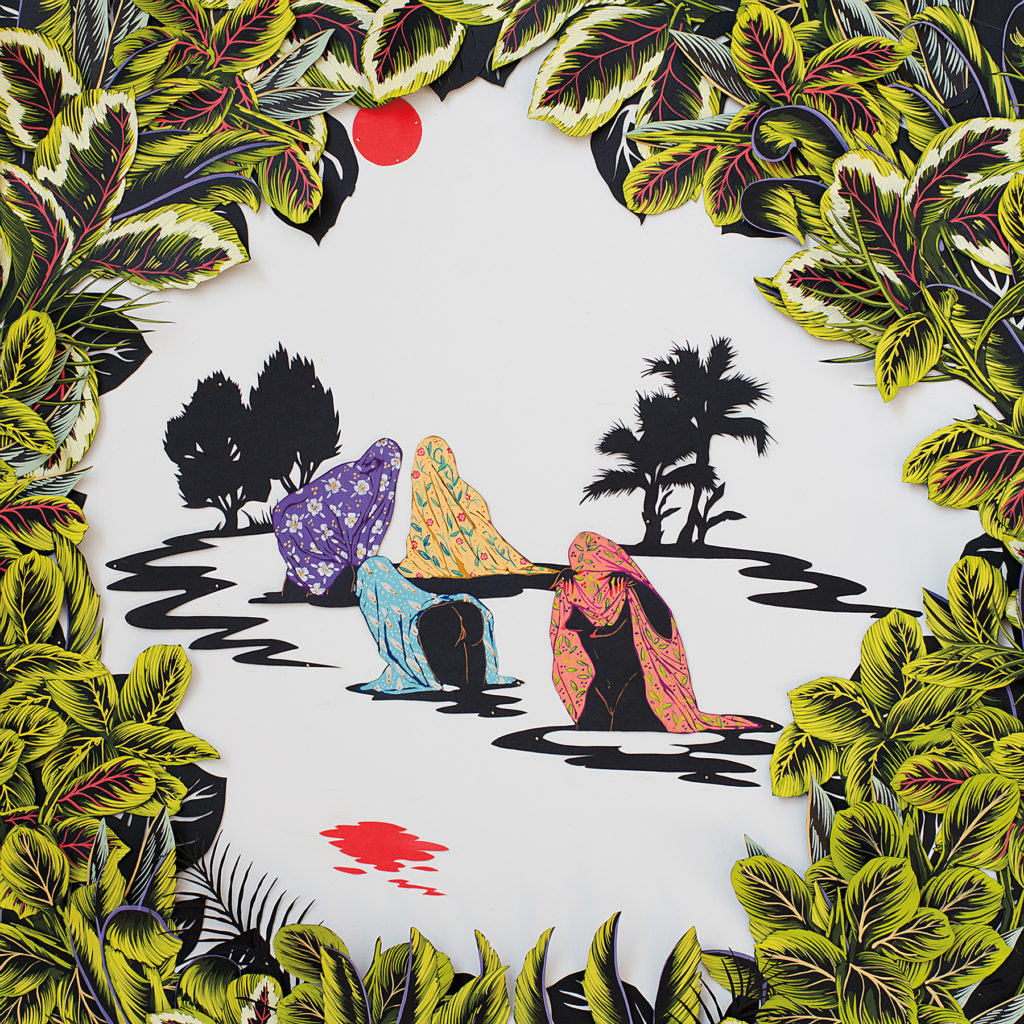 Mia Sandhu, Ablutions (detail), 2018. Cut paper and gouache, 76.2 cm diameter.
Mia Sandhu, Ablutions (detail), 2018. Cut paper and gouache, 76.2 cm diameter.
Mia Sandhu
For the past decade, drawing has been formative to Mia Sandhu’s practice. While the Tkaronto/Toronto artist also creates intricate sculptural installations and paintings on found materials, these are always strongly influenced by the delicate sensibility of her drawn work. In recent years, Sandhu has experimented, to great effect, with cut-paper drawings of shrouded figures amid detailed jungles of brightly painted foliage. In Ablutions (2018), four figures stand almost hip-deep in water, each covered by a swath of beautiful, bright, floral-patterned material. Two figures appear to be whispering to each other through their veils, while one bends at the hips, searching for something in the murky depths, and the figure in the foreground lifts her covering to expose her naked body. In this series, Sandhu is working out the tensions of the body as both the site of shame and, through pleasure, the site of release and personal liberation. For Sandu—whose family on her father’s side is Sikh Punjabi, while her mother’s heritage is white settler Canadian—desire and sexuality feel tenuous and fraught, caught between traditional, conservative spiritual and social values and North America’s hyper-sexual popular culture. With lush leaves that surround the figures and sumptuous textiles tented to create private inner sanctuaries, these paper works represent a rich internal landscape, where tender personal intimacies can grow and blossom.
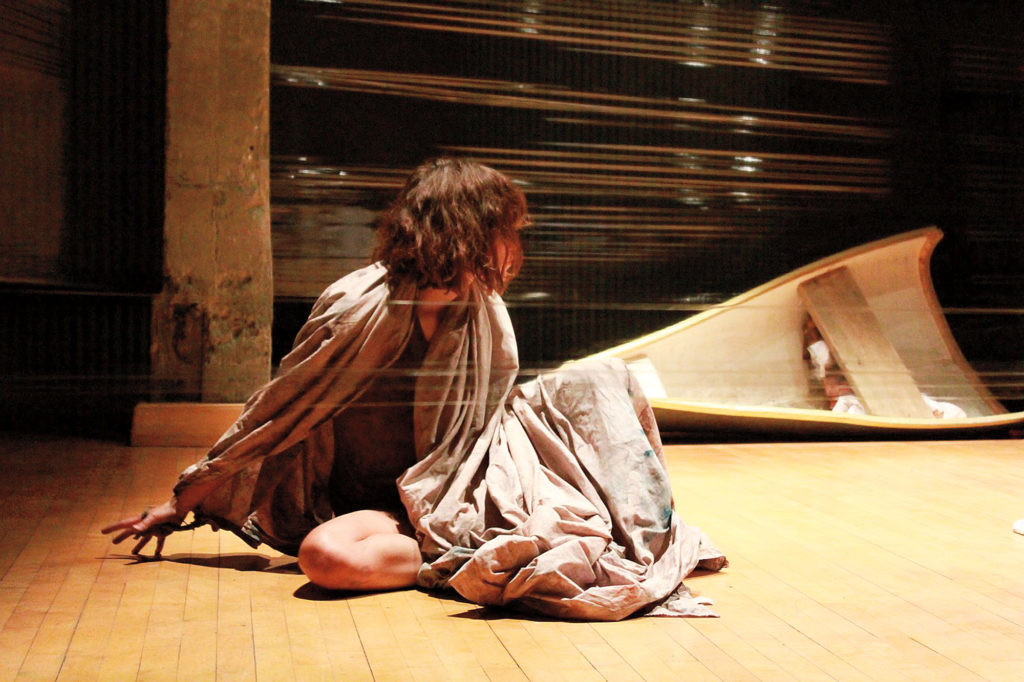 Lara Kramer, Phantom stills & vibrations, 2018. Sound installation and performance. Photo: Doriane Mazaleigue.
Lara Kramer, Phantom stills & vibrations, 2018. Sound installation and performance. Photo: Doriane Mazaleigue.
Lara Kramer
Ojibwe and Cree dancer and choreographer Lara Kramer considers the tensions between Indigenous peoples and settler society in her creations. Based out of Tiohtià:ke/Montreal, Kramer makes work that explores the legacy of the residential school system, colonial violence and its impact on survivors’ and their descendants’ experiences of embodiment in current social systems and cultural worlds. Installations are a component of Kramer’s choreographed pieces, in which the body and its movements carve out space and leave material remnants as a record. For the work Phantom stills & vibrations (2018), presented in collaboration with her partner Stefan Petersen at Artspace in Peterborough, Kramer focused on the construction of an immersive space with a narrative that visitors were invited to piece together. Using research and documentation from Kramer’s multiple visits to Lac Seul First Nation and the surrounding area, where she reconnected with her family and learned their stories, the installation consisted of atmospheric sounds recorded on the water, stacked school benches, a wall of white bed sheets and a photograph of Kramer at the Pelican Falls Residential School, which Kramer’s grandmother attended. While Kramer’s body was absent from the space, it was always implied. The work is a powerful imagining of what it would have been like if her connection to land and family traditions had never been disrupted.
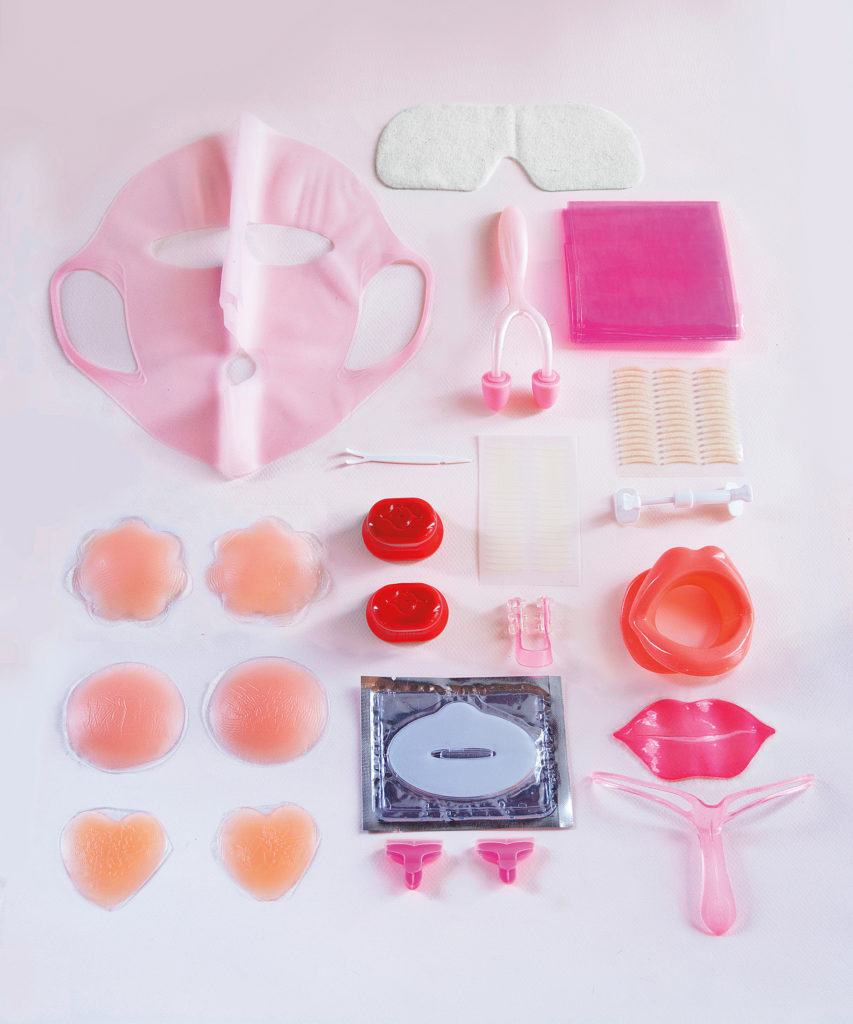 Shellie Zhang, Shapeshifter (from the series Surrogates), 2014–15. Chromogenic print, 60.9 x 50.8 cm.
Shellie Zhang, Shapeshifter (from the series Surrogates), 2014–15. Chromogenic print, 60.9 x 50.8 cm.
Shellie Zhang
Since she was young, Beijing-born, Tkaronto/Toronto artist Shellie Zhang has collected things around her—toys from McDonald’s Happy Meals, small perfume bottles, buttons, quarters and bottle caps—and grouped them on a small shelf in her family home, to suggest a commercial display case. For her Surrogates (2014–15) series, Zhang collected popular consumer products designed to augment, alter or enhance the body, then arranged these objects to emphasize their sterility as bodily surrogates. These works explore the tensions between pleasure and pain—between the affirmative power of self-care rituals (and the commodities that help us battle alienation and burnout) and the nefariousness of unattainable images of perfection, which are used to sell products with the promise of transforming us into prettier, more consumable objects. Purity Control presents an array of products designed to remove dead skin, unwanted hair and impurities. Shapeshifter depicts popular cosmetics marketed toward East Asian consumers to help them achieve idealized (white) Western beauty standards: skin-whitening masks, lip-plumping suction cups, nose ridge–defining rollers and tools to transform eyelids from a “monolid” into a “double” eyelid. The abject pleasure and paradoxical threat explored in Zhang’s Surrogates is in line with a liberal capitalist condition in which consuming objects seems sustaining and using them feels affirming, regardless of whether they improve us and despite the actual physical harm they may cause—something that cultural theorist Lauren Berlant terms “cruel optimism.”
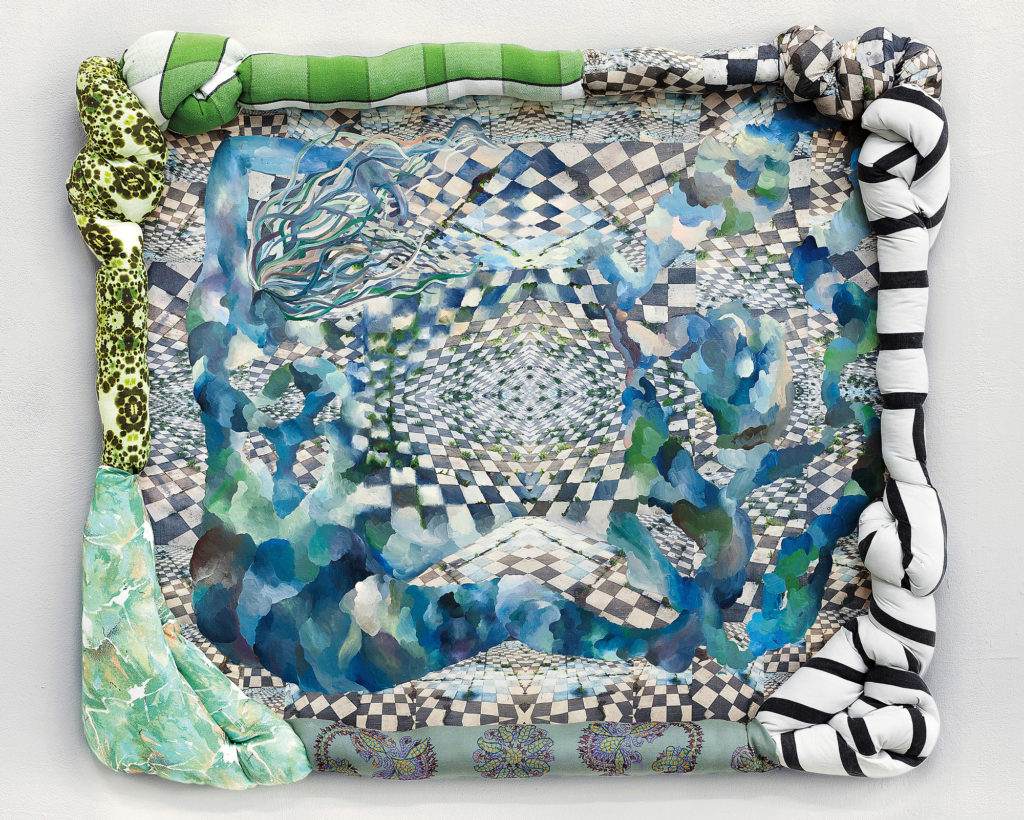 Maya Beaudry, Molding Between, 2017. Oil paint on printed cotton, found fabrics and stuffing, 66 x 101.6 cm.
Maya Beaudry, Molding Between, 2017. Oil paint on printed cotton, found fabrics and stuffing, 66 x 101.6 cm.
Maya Beaudry
Maya Beaudry, who lives and works in Vancouver (situated on the unceded territories of the Musqueam, Squamish and Tsleil-Waututh Nations), thinks of domestic decoration as the membrane between bodies and architecture that provides comfort, ease and livability. “Upholstery is essentially the act of making a hard surface more like a body,” she notes. “So many of our experiences of pleasure occur in these soft parts of the home.” Her work Mold Gardens (on the Ornamental Membrane) (2017) is a small free-standing enclosure that people can enter. The title of the work refers to a short story in which a house is overwhelmed by nature and succumbs to the gradual decay of dereliction. Creative writing and soft sculptural practices have been a way for Beaudry to process the devastating loss of her mother a decade ago. The walls, floors and surfaces inside Mold Gardens are covered with plush textiles layered in folds, pleats and protrusions. Beaudry is fascinated by the way the residue of everyday activity accrues in corners and along edges, as well as in piles and stacks that take on new forms and growths. The built-up space references the body in the fleshiness of the padded textile folds and allusions to decrepitude. It also acts as a soft haven that hints at the melancholy nests created for introspection and recuperation—an immersive archive of spent energy, collected activity and congealed emotion
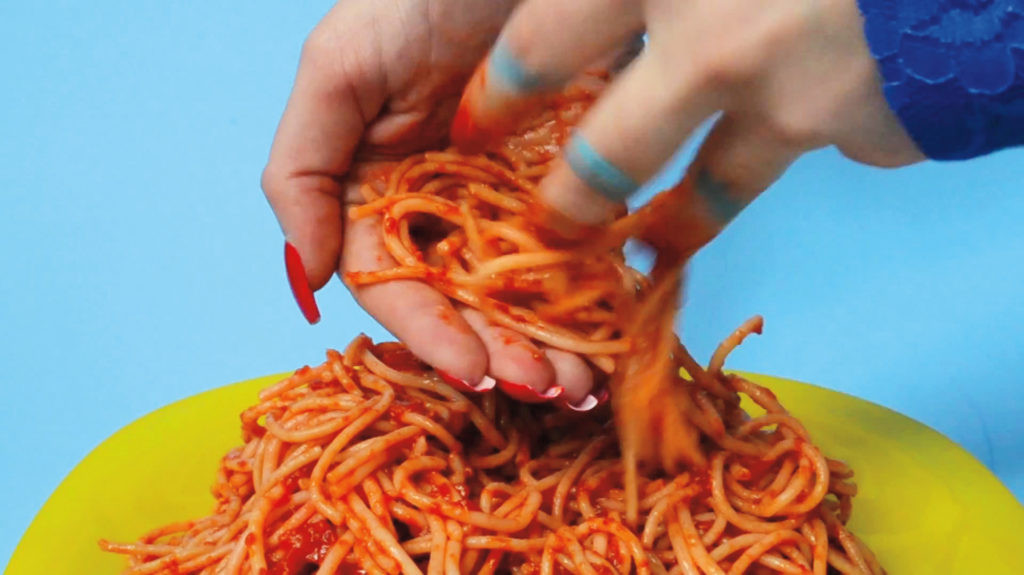 Kylie Dyment and Emily Lawrence, MOUTHFEEL (still), 2016. Single-channel video, 7 minutes, 30 seconds. Courtesy the artists.
Kylie Dyment and Emily Lawrence, MOUTHFEEL (still), 2016. Single-channel video, 7 minutes, 30 seconds. Courtesy the artists.
Kylie Dyment and Emily Lawrence
Artists Kylie Dyment and Emily Lawrence met while attending NSCAD University, where they bonded over their shared experience of growing up with food preparation and delicious tastes. (Dyment’s father is a chef and Lawrence’s is a baker.) Their 2016 immersive exhibition and video, MOUTHFEEL, reveals this shared interest. Accompanied by a score of campy music reminiscent of 1970s advertising jingles, the rambunctious video features vignettes in which a female character—wearing brightly coloured plastic wigs, loud lipstick, striking red press-on nails and kitschy polyester ensembles—manipulates food suggestively. We see her manicured hand stroke an ear of corn against a bright yellow ground. A thick jelly candy “gooshes” as red lips close around it. Pepto-Bismol pours into a quaint vintage soup bowl that says “chowder.” White toothpaste with red and blue stripes squiggles out onto a seat as a blue-and-grey-clad bum slowly sits on the tube. The puckered sphincters of colourful balloons are poked and prodded. Through an appropriation of the pornographic gaze and references to advertising, the video is a smorgasbord of sensorial disjuncture; watching it feels like drinking orange juice when you’re expecting milk. Just as the work disrupts conventions of sexual and commercial visual languages, Dyment and Lawrence interrupted the normative gallery space, with curtains made from colourful plastic tablecloths and beanbag chairs, creating a delightfully playful aesthetic comfortable enough to linger in.
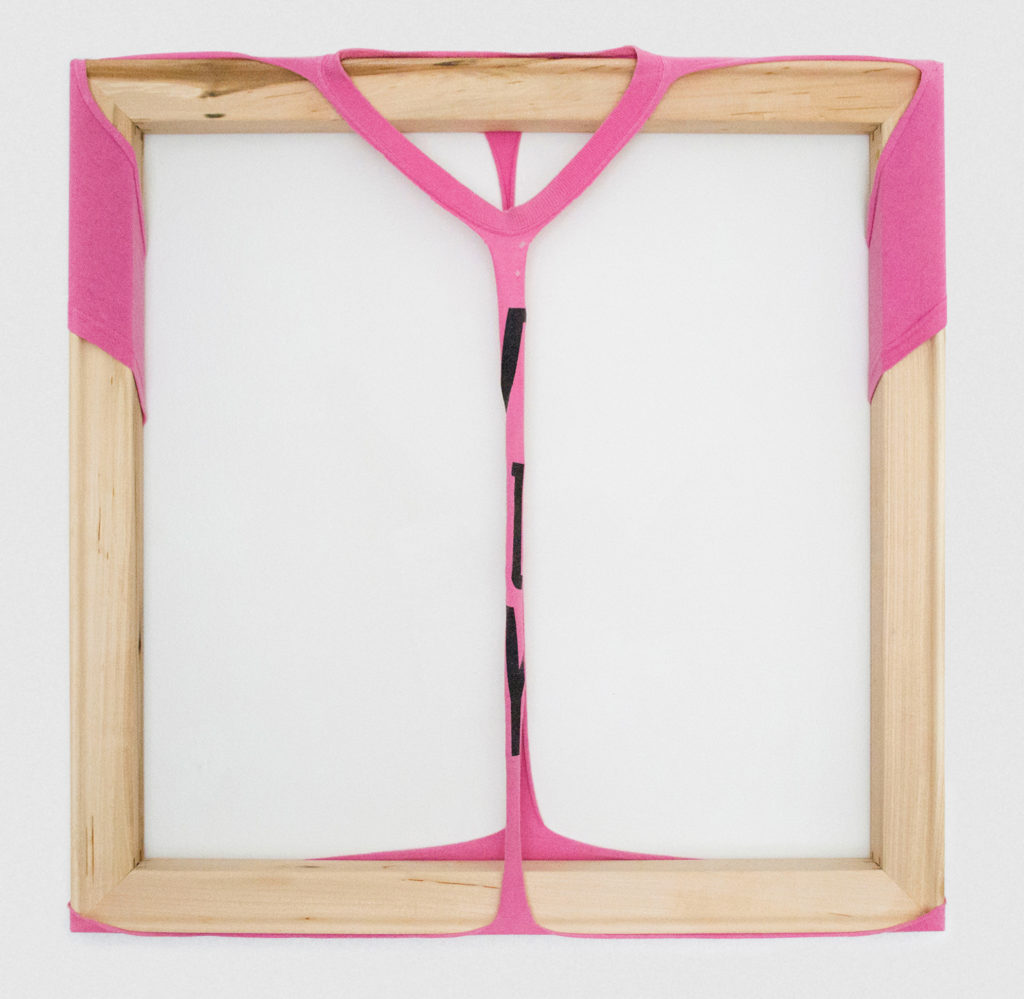 Jade Yumang, Boyfriend Tee (detail), 2015–16. 12 cotton jersey T-shirts altered and stretched over wooden stretchers, 60.9 x 60.9 cm each.
Jade Yumang, Boyfriend Tee (detail), 2015–16. 12 cotton jersey T-shirts altered and stretched over wooden stretchers, 60.9 x 60.9 cm each.
Jade Yumang
Boyfriend Tee (2015–16) by Jade Yumang is a series of 12 cotton jersey T-shirts, pulled taut over two-by-two-foot wooden stretchers and then altered through delicate slices, gaping slashes and intricate knots. The work is a love letter between Yumang, who moved to New York in 2010 to complete his MFA at the Parsons School of Design, and his partner, who remained in Vancouver (situated on the unceded territories of the Musqueam, Squamish and Tsleil-Waututh Nations) where they both grew up. To assuage the homesickness and loneliness, Yumang’s partner sent him his worn T-shirts in the mail. Yumang recalls being comforted by the smell locked into these shirts, and how he would pull them over pillows and sleep and cuddle with them—the scent of his beloved evoking a bodily sense of well-being, closeness and longing. Boyfriend Tee is an homage to how these intimate articles of clothing managed to hold space for their love and maintain an embodied connection stretching over kilometres and years. For Yumang—who recently relocated again, this time from Vancouver to Chicago—the process of slicing into the T-shirts and working them into complex arrangements unleashed all the sentimentality, raw affect and memories of particular times and places stored in the fibres. His practice is one of touch: fingers tracing creases, crevices, solidity and softness— fingers on cotton remembering the feel of a missed person and their body.
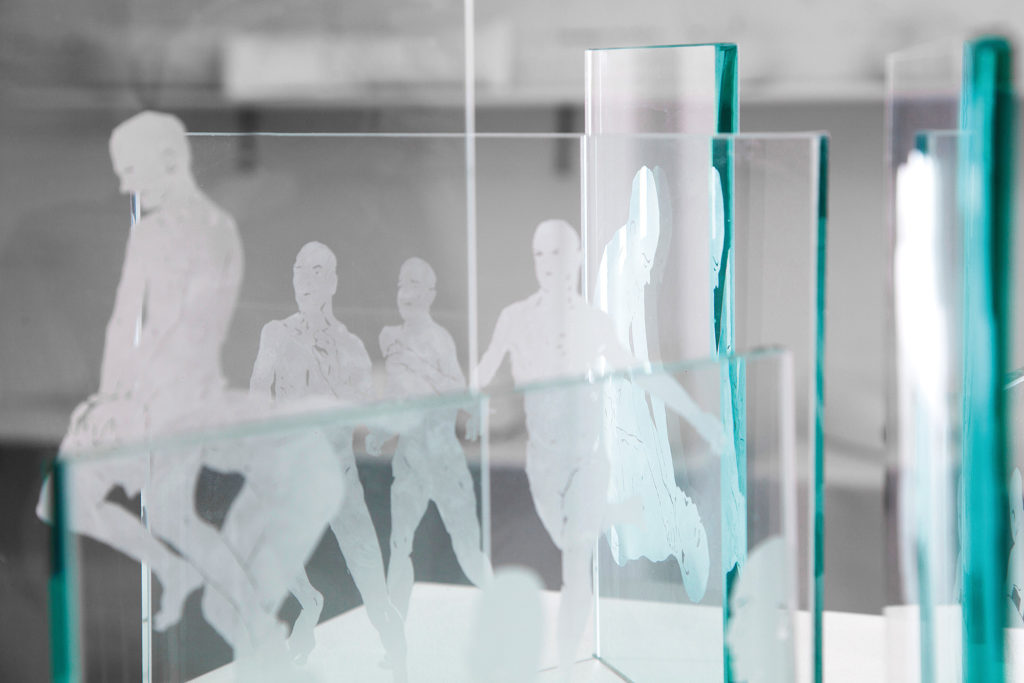 Joshua Vettivelu, there is no difference between nothing and everything when the distance you have built to cope becomes the world (detail), 2018. Etched glass, dimensions variable. Courtesy Towards Gallery. Photo: Yuula Benivolski.
Joshua Vettivelu, there is no difference between nothing and everything when the distance you have built to cope becomes the world (detail), 2018. Etched glass, dimensions variable. Courtesy Towards Gallery. Photo: Yuula Benivolski.
Joshua Vettivelu
How does the world we live in structure our experiences of pleasure? Multidisciplinary Tkaronto/Toronto artist Joshua Vettivelu considers sexual desire and race dynamics in their work and, for them, blogs and websites dedicated to race-play pornography provide a script for the banal, everyday realities of the erotic. In there is no difference… (2018), Vettivelu hand-etched panes of glass with images of aggressive homosocial acts, sourced from Tumblr accounts that focused on gay race-play, with violent, white-supremacist captions attached. The images raise questions about what desire looks like in this charged moment of conservative, alt-right political rhetoric, when it is so often manifest through increased violence against immigrants, newcomers, women, sex workers, queer, transgender and racialized people. Vettivelu observes that desire can become the realm through which privileged, white masculinity seeks power when challenged, with the fantasy of racial supremacy and gender superiority as presented in violent, racist pornography as an example. Vettivelu is uninterested in judging or moralizing kink or fetish, and instead is intent on questioning how, at different times, and over time, institutions of power shape the cosmos of desire and appear within intimate connections. Race-play porn is sought out because it fixes in the body the realities of how racial dynamics play out in intimacy, and how pleasure is accessed and embodied across the traumas of racism and colonization. Following queer theorist José Esteban Muñoz, Vettivelu notes that “the way we choose to desire is world-making.”
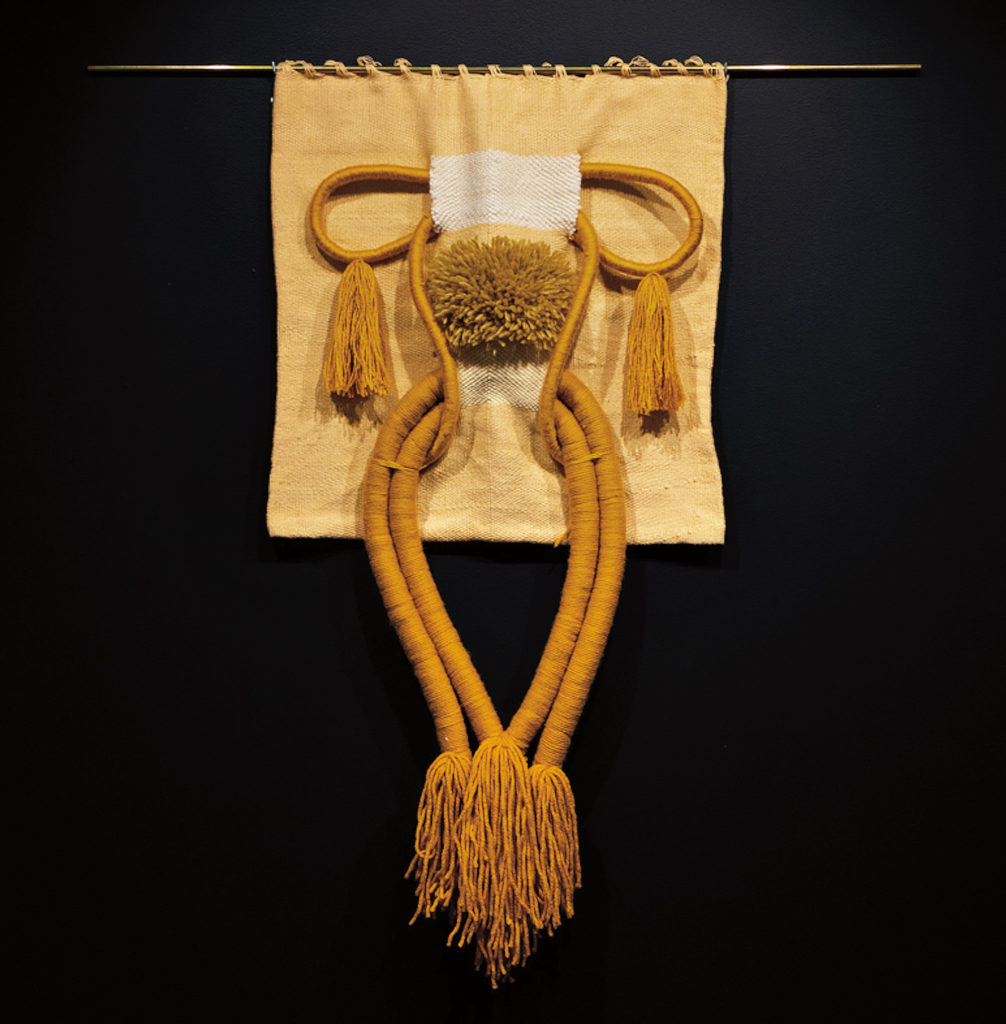 Shaya Ishaq, (Category is) Opulence goes hand in hand with exploitation of our own bodies and yet we are still black gold, 2018. Cotton, acrylic and cotton piping. Photo: Sean Systma.
Shaya Ishaq, (Category is) Opulence goes hand in hand with exploitation of our own bodies and yet we are still black gold, 2018. Cotton, acrylic and cotton piping. Photo: Sean Systma.
Shaya Ishaq
Whole industries and economies are built around how North Americans pursue pleasure in their leisure time. In a recent exhibition at the Ottawa Art Gallery, Kenyan-Canadian artist Shaya Ishaq considered the costs of pleasure through the history of the transatlantic slave trade and the impact of slave labour on the establishment of the United States and Canada in works connecting blue and gold with black—and Blackness. Ishaq explored blue as it pertains to the indigo dyeing traditions of West African societies and the African-American music culture of the Blues—a soulful and embodied expression of the haunting of colonization and the intergenerational trauma resulting from chattel slavery. Photographs from the Daboya series, taken during Ishaq’s three-month-long visit to Ghana in 2016, present figures processing and dyeing cotton in indigo dye vats. Ishaq learned that, on plantations in South Carolina, slave owners preferred enslaved West Africans over indentured Indigenous peoples because of their inherited, embodied knowledge of the processes of indigo dyeing. Another work in the exhibition is a weaving, in various shades of gold and yellow; in an accompanying wall text, Ishaq writes that this work is “Made by my Black hands in celebration of Black spiritual resilience in all corners of the world. Not all our struggles are alike yet we are gold. We are nuanced and yet are gold. We are resilient and we are gold.”
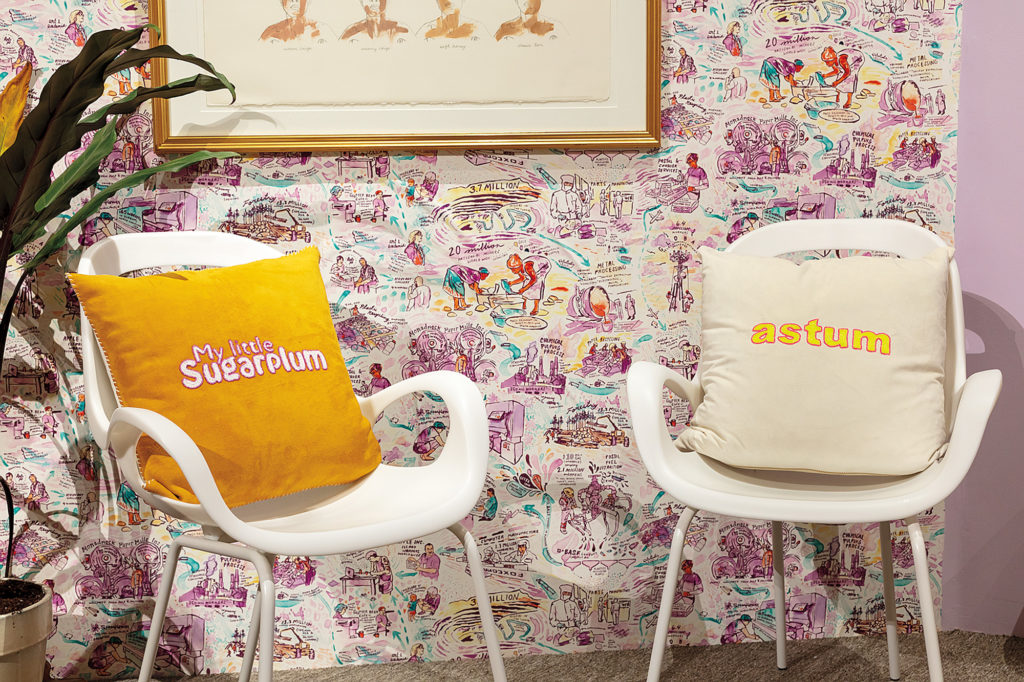 Carrie Allison, Matrilineal Pillows(detail), 2018. Four pillows with embroidery, glass beads, felt, cotton and velvet, 46 x 46 cm each. Photo: Séamus Gallagher.
Carrie Allison, Matrilineal Pillows(detail), 2018. Four pillows with embroidery, glass beads, felt, cotton and velvet, 46 x 46 cm each. Photo: Séamus Gallagher.
Carrie Allison
Cree, Métis and settler artist Carrie Allison’s Matrilineal Pillows (2018) is a series of four cushions, each beaded or embroidered with a favourite saying by a woman on her mother’s side of the family. “These pillows are imbued with pleasure,” Allison says with an obvious gush of delight. The K’jipuktuk/Halifax-based artist describes the pleasure she felt in her body as she spent hours sewing shiny beads and glossy embroidery thread on felt, velvet, velour, hide and cotton. It was time dedicated to honouring the comforts her great-grandmother, grandmother, great-aunt and mother have provided throughout her life. Mom’s Pillow says “My little Sugarplum” in white beads outlined in pink beads, while the pillow for her great-aunt Ivy says “astum” (a Cree word meaning “come here”) in bright yellow and pink beads on creamy velour. These pillows evoke the joy Allison felt in the comfort of home and family—the bodily sensation of embraces and words of endearment—but they also speak about how difficult intimacy, affection and pleasure are in the wake of trauma. Allison’s grandmother was a residential school survivor; she reflects on the damage and violence of this experience as a spiritual and emotional wound affecting the family culture of intimacy. For Allison, Matrilineal Pillows is an opportunity to pull these women close to her, to celebrate their resilience and to hold them and heal the legacy of hurt through repetitive and reparative gestures of pleasure.

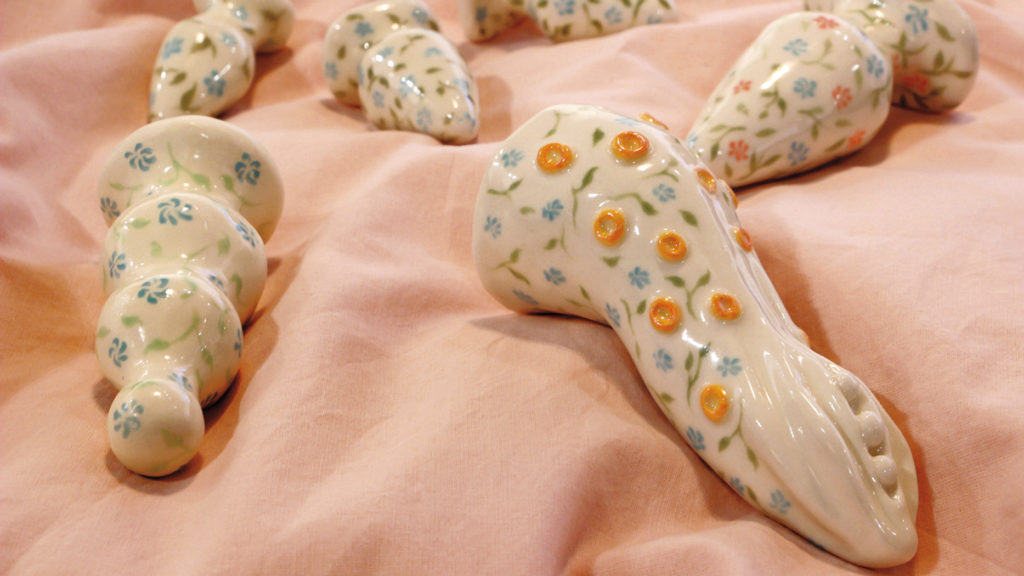 Anna Joan Taylor, Sex Toys, 2018. Hand-painted porcelain, dimensions variable. Photo: Julie Hollenbach.
Anna Joan Taylor, Sex Toys, 2018. Hand-painted porcelain, dimensions variable. Photo: Julie Hollenbach.
